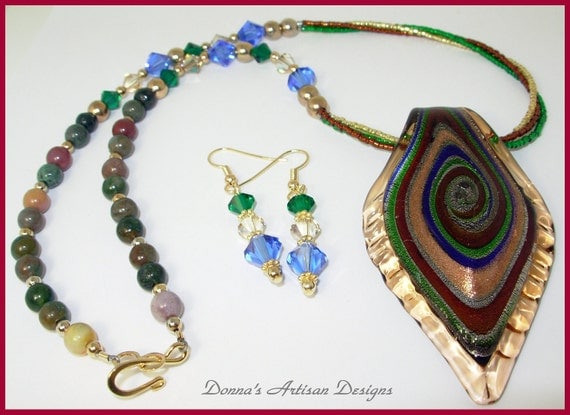JET, Jewelry on Etsy Team: All the Shades of the Sun from the JETs
These gorgeous treasuries were compiled by our very own Norah from Your Daily Jewels and features out JET Team. I'm sure you will find just the perfect item for yourself or another among the beauties listed here!!!
My Blog will be used along with my Website & Etsy Store.I will feature my jewelry designs, inspirations & share some helpful info for fellow Artisans. I am a proud member of the JET Team on Etsy & hope to include other team members as well their blogs & shops! Iwill offer useful info for the handmade jewelry artisan with tutorials,valued bead sources.info about semi-precious stones,metals,design,wire wrapping, etc I hope you find something useful here you like!
Sunday, August 28, 2011
Sunday, August 21, 2011
Wednesday, August 17, 2011
Tuesday, August 9, 2011
Thursday, August 4, 2011
Dichroic Glass
Dichroism
From Wikipedia, the free encyclopedia
Dichroism has two related but distinct meanings in optics. A dichroic material is either one which causes visible light to be split up into distinct beams of different wavelengths (colours) (not to be confused with dispersion), or one in which light rays having different polarizations are absorbed by different amounts.[1]
References
^ University Physics 6th Ed. F.W. Sears, M.W. Zemansky, H.D. Young ISBN 02101071991
The original meaning of dichroic, from the Greek dikhroos, two-coloured, refers to any optical device which can split a beam of light into two beams with differing wavelengths. Such devices include mirrors and filters, usually treated with optical coatings, which are designed to reflect light over a certain range of wavelengths, and transmit light which is outside that range.
Dichroic glass is glass containing multiple micro-layers of metal oxides which give the glass dichroic optical properties. The invention of dichroic glass is often erroneously attributed to NASA and its contractors[1], who developed it for use in dichroic filters. Dichroic glass dates back to at least the 4th century AD as seen in the Lycurgus cup.[2] Dichroic glass is an example of thin-film optics.
Multiple ultra-thin layers of different metals (gold, silver), metal oxides (titanium, chromium, aluminium, zirconium, magnesium) and silica are vaporised by an electron beam in a vacuum chamber. The vapour then condenses on the surface of the glass in the form of a crystal structure. This is sometimes followed by a protective layer of quartz crystal.[3]
Dichroic glass is now available to artists through dichroic coating manufacturers. Glass artists often refer to dichroic glass as "dichro".[4] The main characteristic of dichroic glass is that it has a transmitted colour and a completely different reflected colour, as certain wavelengths of light either pass through or are reflected. This causes an array of colour to be displayed. The colors shift depending on the angle of view.
Dichroic glass is specifically designed to be hotworked but can also be used in its raw form. Sculpted glass elements that have been shaped by extreme heat and then fused together may also be coated with dichroic afterwards to make them reflect an array of colors.
References
^ High Tech Art: Chameleon Glass
. NASA. 1993. ISBN 0160421004.
^ "The Lycurgus Cup - The British Museum"
.
^ a b c d FAQs on Dichroic Glass
, Coatings by Sandberg, Inc.
From Wikipedia, the free encyclopedia
Dichroism has two related but distinct meanings in optics. A dichroic material is either one which causes visible light to be split up into distinct beams of different wavelengths (colours) (not to be confused with dispersion), or one in which light rays having different polarizations are absorbed by different amounts.[1]
References
^ University Physics 6th Ed. F.W. Sears, M.W. Zemansky, H.D. Young ISBN 02101071991
The original meaning of dichroic, from the Greek dikhroos, two-coloured, refers to any optical device which can split a beam of light into two beams with differing wavelengths. Such devices include mirrors and filters, usually treated with optical coatings, which are designed to reflect light over a certain range of wavelengths, and transmit light which is outside that range.
Dichroic glass is glass containing multiple micro-layers of metal oxides which give the glass dichroic optical properties. The invention of dichroic glass is often erroneously attributed to NASA and its contractors[1], who developed it for use in dichroic filters. Dichroic glass dates back to at least the 4th century AD as seen in the Lycurgus cup.[2] Dichroic glass is an example of thin-film optics.
Multiple ultra-thin layers of different metals (gold, silver), metal oxides (titanium, chromium, aluminium, zirconium, magnesium) and silica are vaporised by an electron beam in a vacuum chamber. The vapour then condenses on the surface of the glass in the form of a crystal structure. This is sometimes followed by a protective layer of quartz crystal.[3]
Dichroic glass is now available to artists through dichroic coating manufacturers. Glass artists often refer to dichroic glass as "dichro".[4] The main characteristic of dichroic glass is that it has a transmitted colour and a completely different reflected colour, as certain wavelengths of light either pass through or are reflected. This causes an array of colour to be displayed. The colors shift depending on the angle of view.
Dichroic glass is specifically designed to be hotworked but can also be used in its raw form. Sculpted glass elements that have been shaped by extreme heat and then fused together may also be coated with dichroic afterwards to make them reflect an array of colors.
References
^ High Tech Art: Chameleon Glass
. NASA. 1993. ISBN 0160421004.
^ "The Lycurgus Cup - The British Museum"
.
^ a b c d FAQs on Dichroic Glass
, Coatings by Sandberg, Inc.
Subscribe to:
Posts (Atom)



